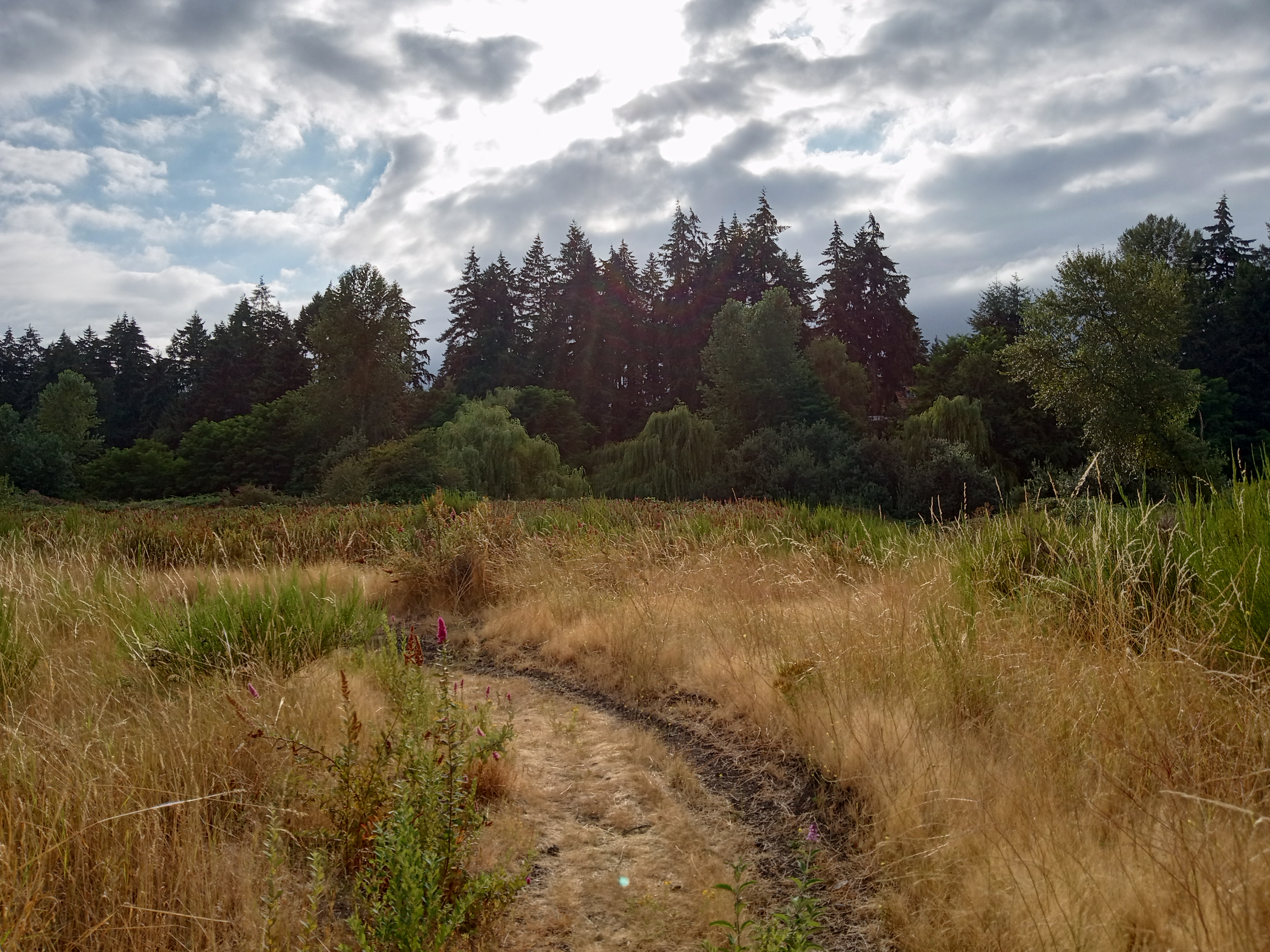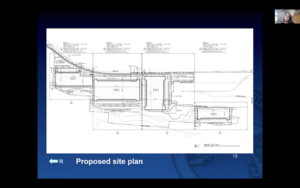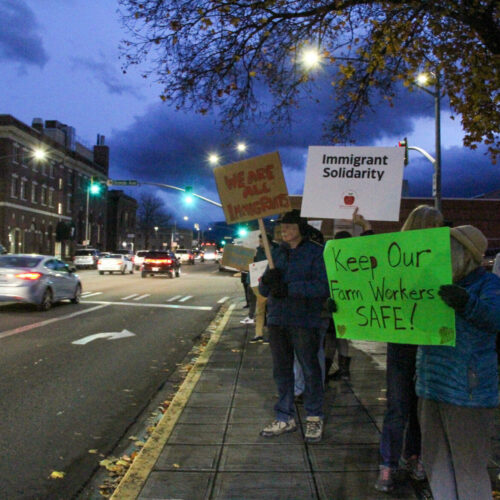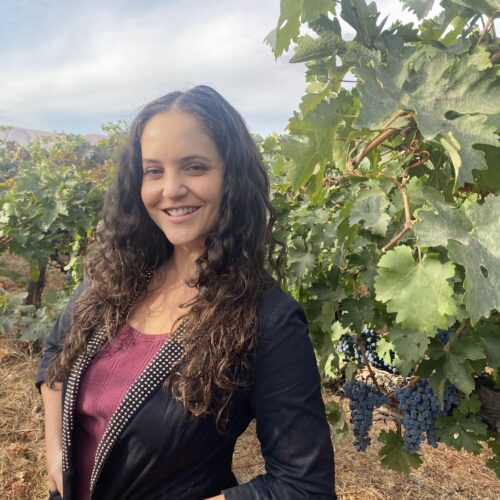
Environmental justice concerns raised over Bridge Industrial warehouse proposal
Listen
(Runtime 3:48)
Read
South Tacoma is heavily populated by industry, covered with concrete and pavement, where traffic clogs up around commuting times.
Alejandro Fernández has lived in the area since 2018, and he knows the industrialization of the neighborhood well. Still, he and others who call the area home enjoy the remaining Garry oak trees and green spaces.
About a five minute drive from his home, a proposal would develop a 2.5 million square foot mega-warehouse complex. Fernández is against the development, in part, because he said the area would lose green space.
Speaking about the plot of land, Fernández said, “It’s got old-growth Garry oak trees. It’s got Douglas fir trees that are over 100 feet tall. On the edge of it, it’s got wetlands. It’s got coyotes.”
Moreover, Fernández said, residents could face air quality degradation and increases in traffic from the development.
“These neighborhoods where they’re going to put (the warehouses), people are suffering from asthma. People are suffering from smog, pollution, air pollution, noise pollution,” Fernández said, referring to the health problems already caused by the high volume of traffic, nearby train tracks and flyovers from Joint Base Lewis-McChord.

The proposed site plan for the Bridge Industrial warehouse in the Tacoma Mall neighborhood.
According to the Washington State Environmental Health Disparities map, communities that surround the site where the warehouse could be developed already rank at the highest level for diesel exhaust emissions. People can inhale fine particulates from diesel exhaust, which can cause respiratory and other health issues.
From air pollution to noise pollution to the hotter temperatures caused by urban heat island effect, Fernández said the South Tacoma area is overburdened by environmental justice issues. This development would only make those issues worse, he said.
“There’s a lot of issues at stake,” Fernández said. “It’s an environmental justice issue because it has people of color that live in the neighborhood, poor people that live in the neighborhood.”
The city of Tacoma is still in the permitting process for the warehouse proposed by Bridge Industrial, a commercial industrial real estate company that may plan to lease the warehouse space if it’s built. Beyond area residents expressing concerns about the proposed development, county, state and federal agencies are voicing their opinions.
The Tacoma Pierce County Health Department, Washington State Department of Health, the Environmental Protection Agency and the Washington State Department of Ecology all sent comment letters to the city expressing concerns about environmental equity in a neighborhood that’s already overburdened and underserved.
In a letter sent via email in September to Shirley Schultz, principal planner for the city, the Washington State Department of Ecology commented on air quality concerns with the potential development.
In response to a request for an interview, Schultz said the city cannot comment during the permit review process beyond what’s in public documents. Officials with Bridge Industrial also did not respond to interview requests.
Rich Doenges, the Southwest Region director with the Department of Ecology, penned the Department of Ecology’s letter.
According to the letter, the warehouse could add around 1,400 diesel truck trips per day. That amount of traffic could cause more air quality problems for these communities that already breathe in high levels of diesel exhaust, Doenges said.
A clean air permit would be the responsibility of the Puget Sound Clean Air Agency. But, Doenges said Department of Ecology officials felt it’s important for the city of Tacoma to pay closer attention to impacts from diesel trucks that would be coming and going from the warehouse.
“That’s really something that all state agencies need to do because of Washington’s first environmental justice law, the Healthy Environment for All Act,” Doenges said.
The Healthy Environment for All Act, or HEAL Act, is meant to reduce environmental and health disparities across the state.
According to the American Bar Association, the act requires equitable participation in permitting decisions and for those permitting decisions to lead to equitable outcomes.
Officials with the Department of Ecology would like to see the city of Tacoma expand its air quality analysis of the development, including other traffic in the area beyond idling vehicles on the site. The department wants the analysis to specifically focus on diesel truck traffic and emissions.
The department wants the city to expand on potential mitigation measures, suggesting increases in traffic from the warehouse development would harm community well-being.
“It’s really a basic fairness issue,” Doenges said. “Mitigation should occur everywhere.”
According to an air quality study completed this May for the proposal, the Washington State Clean Air Act does not require analysis of new emissions for mobile emission sources, like vehicles.
However, Doenges said, while permits analyze stationary emission sources, environmental impact statements should look at air quality impacts in the area beyond stationary sources.
As Doenges looks to the future, he said electric vehicles could reduce emissions.
“Hopefully these impacts from internal combustion engines are going to diminish in the near future, but right now, they’re certainly there,” Doenges said.
According to letters from other agencies, the Washington State Department of Health would like an expanded Health Impact Assessment focusing on environmental justice. Right now, the city of Tacoma is conducting a rapid health assessment on the project.
To expand the health assessment, the Tacoma-Pierce County Health Department offered to help with an intermediate level health assessment, which would go one step beyond the current rapid assessment.
Rad Cunningham, a senior epidemiologist with the state Department of Health, said the rapid Health Impact Assessment, or HIA, would forgo key community engagement.
“The key component of an HIA is the community engagement piece,” Cunningham said. “So really giving the community some say, some power in these developments that impact them.”
Cunningham said the Department of Health is tasked with developing community engagement plans under the HEAL Act. He said the health department has seen the value of community engagement.
“The point of the HEAL Act and the community engagement pieces is: we want to move toward empowerment of communities to make decisions like this for themselves,” Cunningham said.
Cunningham said he thinks an expanded health assessment would help residents and the city better understand the health impacts from this potential warehouse development. It would then help people make the best decisions on how to move forward.
But, he said the Department of Health hasn’t heard a response since its September letter to the city.
South Tacoma resident Alejandro Fernández said he would like the city to deny the permit. But, he also wants more transparency in the permit decision process.
“I would like to see the city say no and deny the permit to it,” Fernández said. “And start establishing something where you’re a little bit more inclusive with community members.”
Fernández said he found out about the proposed development through a non-profit’s social media. Other residents also expressed frustration over the short notice to provide public comment.
The city held more virtual public comment periods after many people expressed concerns. A handful of people also showed up to last week’s Tacoma City Council public forum to voice their opinions about the potential development.
Fernández said he hasn’t heard from the city for months. He said he doesn’t understand why the city of Tacoma can’t provide more updates during the review.
“The planning department needs to do a better job of bringing the people together again – at a public park or something, at a community center – and saying, ‘This is where we’re at. We’re still planning,’” Fernández said.















